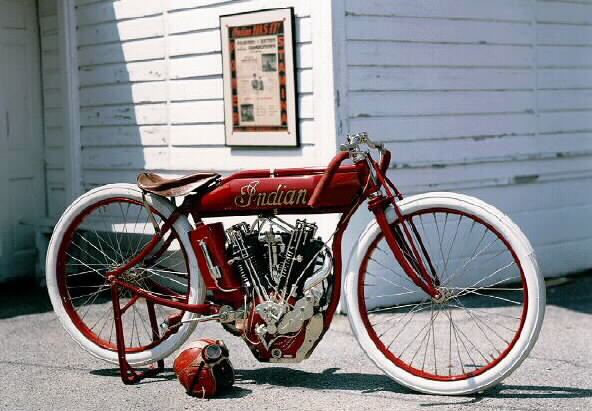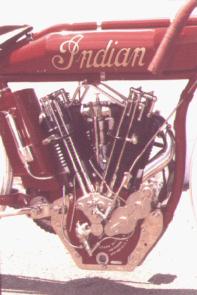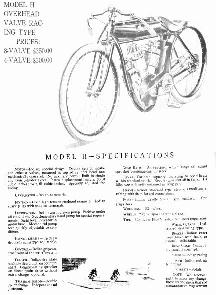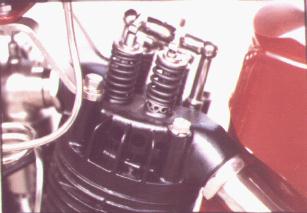|
1918 Indian 8-Valve Racer

By Dave Tharp, Virtual
Museum Curator
Photos by Mark Mitchell Photography
 Bicycle racing on banked, wooden velodromes was enormously popular
at the turn of the 20th century. Many of the very first machines
identifiable as motorcycles were built by bicycle mechanics, and
were used as "pacers" to train bicycle racers. The first race
probably occurred the first time that two of them happened to
be on the track at the same time.
Bicycle racing on banked, wooden velodromes was enormously popular
at the turn of the 20th century. Many of the very first machines
identifiable as motorcycles were built by bicycle mechanics, and
were used as "pacers" to train bicycle racers. The first race
probably occurred the first time that two of them happened to
be on the track at the same time.
Oscar Hedstrom was one of these enterprising young
mechanics, and his design was so elegant and reliable that it
was produced in quantity by the Hendee Manufacturing Company as
the first Indian motorcycle.
Timber was cheap, labor was plentiful, and board
track racing offered a level of spectacle not seen since Roman
times. With the help of an engineer from New Jersey by the name
of Jack Prince -- who sought to build a chain of large tracks
from coast to coast -- board track races spread across the nation
like wildfire. The Coliseum in Los Angeles, over a quarter mile
long, was opened in 1909, followed immediately by a one-third
mile bowl in Springfield, Mass., and in 1910 by full mile-long
tracks in Playa del Rey, California (a suburb wedged between Los
Angeles and the Pacific ocean) and Salt Lake City, Utah. Tracks
up to two miles in length were thrown up in 1911 in Oakland, Denver,
Buffalo, Cleveland, Chicago, and Detroit. 1912 brought tracks
to Milwaukee, Omaha, Houston, Cleveland and Atlantic City. Race
promoters made wads of money, with $10,000 daily gate receipts
a common draw.
 Very high speeds and a complete lack of safety precautions
lead to spectacular wrecks on the board tracks in the 1910s, often
killing a half-dozen competitors and spectators at a time. Controversy
over safety had already caused the national sanctioning organization
to switch the 1913 National Championship
Races over from the boards to the safer, but less profitable,
dirt ovals. True to form, racing improved the breed. Motorcycles
went from able-to-keep-up-with-bicycles in 1900 to the first 100-mph
average lap, turned by Lee Humiston on a "Big-Valve" Excelsior
at the Playa del Rey track in 1912. Technical competition among
the manufacturers was just as fierce as the racing itself. The
race for prestige led famous manufacturers like Indian, Excelsior,
Cyclone, Thor, and Flying Merkel to develop purpose-built racing
equipment with the highest attainable horsepower they could squeeze
from their motors. Very high speeds and a complete lack of safety precautions
lead to spectacular wrecks on the board tracks in the 1910s, often
killing a half-dozen competitors and spectators at a time. Controversy
over safety had already caused the national sanctioning organization
to switch the 1913 National Championship
Races over from the boards to the safer, but less profitable,
dirt ovals. True to form, racing improved the breed. Motorcycles
went from able-to-keep-up-with-bicycles in 1900 to the first 100-mph
average lap, turned by Lee Humiston on a "Big-Valve" Excelsior
at the Playa del Rey track in 1912. Technical competition among
the manufacturers was just as fierce as the racing itself. The
race for prestige led famous manufacturers like Indian, Excelsior,
Cyclone, Thor, and Flying Merkel to develop purpose-built racing
equipment with the highest attainable horsepower they could squeeze
from their motors.
In 1916, Indian introduced the Model H racer, and
placed it on sale to the public at the astronomical price of $350.
It featured overhead-valve heads with four valves per cylinder,
and was easily capable of speeds of over 120 mph. In various forms,
it was raced on the dirt track as well as on the boards with very
great success. It is unknown how many of the 8-valve racers were
manufactured, but production was very small indeed; most machines
were ridden either by factory riders or were "loaned" to promising
privateers.
 This beautiful 1918 8-valve racer, restored by Brad Wilmarth
of Petersburg, Virginia and owned by Daniel Statnekov of Sante
Fe, New Mexico, sports a prototype "Marion" frame, which made
its formal debut at the Marion, Indiana 200-mile road race of
1919. It received the highly coveted "Red" Wolverton award for
the best restored machine at the 1996 AMCA National Meet at Oley,
Pennsylvania, achieving a full 100 points. It is currently on
display at the Vintage Museum in Oxnard, California.
This beautiful 1918 8-valve racer, restored by Brad Wilmarth
of Petersburg, Virginia and owned by Daniel Statnekov of Sante
Fe, New Mexico, sports a prototype "Marion" frame, which made
its formal debut at the Marion, Indiana 200-mile road race of
1919. It received the highly coveted "Red" Wolverton award for
the best restored machine at the 1996 AMCA National Meet at Oley,
Pennsylvania, achieving a full 100 points. It is currently on
display at the Vintage Museum in Oxnard, California.
Although the bike has been run, its proper place
is in a museum. Like the other board track bikes of its era, it
lacks such amenities as brakes, a clutch, or even a throttle (carbs
were run wide open, with the only control of the engine speed
being an ignition cut-out). It's basically a deathtrap.
But no matter what the era, racebikes always look fast!
Back to the Classic Bikes page
|

